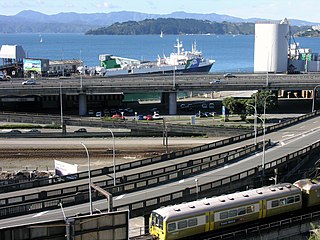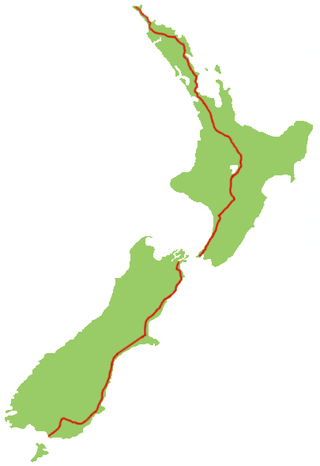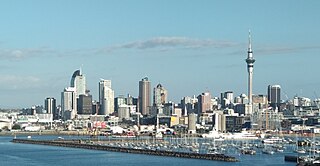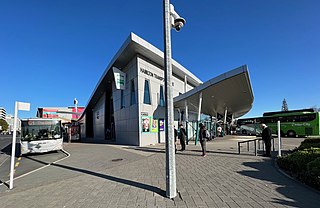Related Research Articles

Transport in New Zealand, with its mountainous topography and a relatively small population mostly located near its long coastline, has always faced many challenges. Before Europeans arrived, Māori either walked or used watercraft on rivers or along the coasts. Later on, European shipping and railways revolutionised the way of transporting goods and people, before being themselves overtaken by road and air, which are nowadays the dominant forms of transport. However, bulk freight still continues to be transported by coastal shipping and by rail transport, and there are attempts to (re)introduce public transport as a major transport mode in the larger population centres.
The New Zealand state highway network is the major national highway network in New Zealand. Nearly 100 roads in the North and South Islands are state highways. All state highways are administered by the NZ Transport Agency.
Jafa is a slang term for a resident of Auckland, New Zealand. It is an acronym, standing for Just Another Fucking Aucklander. This prejudice against Aucklanders started to appear around the 1900s, when Premier Richard John Seddon referred to Aucklanders as "Rangitoto Yanks," and is considered to be representative of the boorishness of Aucklanders, or the envy of the rest of New Zealand, depending on the perspective. The term is also misspelled as Jaffa, a chocolate confection from Dunedin, and is often used in sentences which render the original term useless in the grammatical sense. The term has wider currency than the earlier derogatory term "Rangitoto Yank". A variant is Jaffa, Just Another Fuckwit From Auckland.

The Auckland Harbour Bridge is an eight-lane motorway bridge over the Waitematā Harbour in Auckland, New Zealand. It joins St Marys Bay on the Auckland city side with Northcote on the North Shore side. It is part of State Highway 1 and the Auckland Northern Motorway. The bridge is operated by the NZ Transport Agency (NZTA). It is the second-longest road bridge in New Zealand, and the longest in the North Island.

Rail transport in New Zealand is an integral part of New Zealand's transport network, with a nationwide network of 4,375.5 km (2,718.8 mi) of track linking most major cities in the North and South Islands, connected by inter-island rail and road ferries. Rail transport in New Zealand has a particular focus on bulk freight exports and imports, with 19 million net tonnes moved by rail annually, and 99.5% of New Zealand's exports and imports being transported through the country's seaports.

Māngere Bridge, officially also called the Manukau Harbour Crossing, is a dual motorway bridge over the Manukau Harbour in south-western Auckland, New Zealand, crossing between the suburb also known as Māngere Bridge and the suburb of Onehunga.

State Highway 1 is the longest and most significant road in the New Zealand road network, running the length of both main islands. It appears on road maps as SH 1 and on road signs as a white number 1 on a red shield, but it has the official designations SH 1N in the North Island, SH 1S in the South Island.
Transit New Zealand, which existed from 1989 to 2008, was the New Zealand Crown entity responsible for operating and planning the New Zealand state highway network. It also concerned itself with developments close to state highways, as it considered the potential additional traffic that these would create, and it was responsible for state highway landscaping.
Transport in Auckland, New Zealand's largest city, is defined by factors that include the shape of the Auckland isthmus, the suburban character of much of the urban area, a history of focusing investment on roading projects rather than public transport, and high car-ownership rates.

Ports of Auckland Limited (POAL), the successor to the Auckland Harbour Board, is the Auckland Council-owned company administering Auckland's commercial freight and cruise ship harbour facilities. As the company operates all of the associated facilities in the Greater Auckland area, this article is about both the current company and the ports of Auckland themselves.

Public transport in New Zealand exists in many of the country's urban areas and takes a number of forms. Bus transport is the main form of public transport. Two major cities, Auckland and Wellington also have suburban rail systems that have been gaining more patronage and new investment in recent years. Some cities also operate local ferry services. There are no rapid transit metros and no remaining tram systems active anywhere in New Zealand, though trams once had a major role in New Zealand's public transport.

Trams in New Zealand were a major form of transport from the 19th century into the mid-20th century. New Zealand's first (horse) tramway was established in 1862 (Nelson), followed by a steam tramway in 1871 (Thames), and the first electric tramway in 1900. In New Zealand railway terminology a bush tramway is an industrial tramway, which usually did not carry passengers.
KiwiRail Holdings Limited is a New Zealand state-owned enterprise (SOE) responsible for rail operations in New Zealand and operates inter-island ferries. Trading as KiwiRail and headquartered at 604 Great South Road, Ellerslie, KiwiRail is the largest rail transport operator in New Zealand. KiwiRail has business units of KiwiRail Freight, Great Journeys New Zealand and Interislander. The company was formed in 2008 when the government renationalised above-rail operations and inter-island ferry operations, then owned by Toll Holdings. In 2021, the government launched the New Zealand Rail Plan, with funding for rail projects to come from the National Land Transport Fund (NLTF), and with KiwiRail remaining an SOE but paying Track Access Charges (TACs) to use the network.

Auckland is a large metropolitan city in the North Island of New Zealand. It has an urban population of about 1,478,800. It is located in the greater Auckland Region, the area governed by Auckland Council, which includes outlying rural areas and the islands of the Hauraki Gulf, and which has a total population of 1,739,300 as of June 2023. It is the most populous city of New Zealand and the fifth largest city in Oceania. While Europeans continue to make up the plurality of Auckland's population, the city became multicultural and cosmopolitan in the late-20th century, with Asians accounting for 31% of the city's population in 2018. Auckland has the fourth largest foreign-born population in the world, with 39% of its residents born overseas. With its large population of Pasifika New Zealanders, the city is also home to the biggest ethnic Polynesian population in the world. The Māori-language name for Auckland is Tāmaki Makaurau, meaning "Tāmaki desired by many", in reference to the desirability of its natural resources and geography.

Cycling in New Zealand is the 5th most popular form of active recreation, but a very marginal commuting mode, with the share hovering around 1–3% in most major cities. This is due to a number of factors, principally safety fears.

Steven Leonard Joyce is a New Zealand former politician, who entered the New Zealand House of Representatives in 2008 as a member of the New Zealand National Party. As a broadcasting entrepreneur with RadioWorks, he was a millionaire before he entered politics. In 2008 he became Minister of Transport and Minister for Communications and Information Technology. He later became Minister of Science and Innovation, and then served as Minister of Finance and Minister for Infrastructure.

Public transport in Hamilton and the Waikato Region consists mainly of bus services, as well as some limited train and ferry services. Services are mainly infrequent and investment hasn't been sufficient to compete with cars, so that subsidies, first introduced in 1971, have increased.
National Ticketing Solution (NTS) is a public transport payment system in development for New Zealand. It is contracted to American company Cubic. It is expected to start roll out in the Canterbury region in 2024 and available nationwide by 2026.
References
- 1 2 3 Enews April 2004 Archived 2006-09-24 at the Wayback Machine (Futureintech, Government-funded initiative of IPENZ)
- ↑ Where transportation and people meet (Traffic Design Group website)
- ↑ Council Agenda, Thursday 5 March 1998 (Christchurch City Council)
- 1 2 "Third Joint Statement Of Traffic Experts, In The Matter Of: Applications by Mighty River Power Limited to Palmerston North City Council, Horizons Regional Council and Tararua District Council for Resource Consents for the Turitea Wind Farm Proposal" (PDF). 2009. Retrieved 27 January 2011.
- ↑ "Stantec acquires TDG".
- ↑ "Stadium decision: Noise 'not a problem' at waterfront". The New Zealand Herald . 22 November 2006. Retrieved 27 January 2011.
- ↑ Oliver, Paula (22 November 2006). "Stadium decision: Government defends law changes". The New Zealand Herald . Retrieved 24 November 2011.
- ↑ SH20 Hillsborough to Richardson Road - Assessment of Effects on the Environment Archived 2007-09-28 at the Wayback Machine (Auckland City Council)
- ↑ Ins and Outs of Roundabouts (Land Transport New Zealand)
- ↑ State Highway Traffic Volumes 2001-2005 Archived 2007-02-21 at the Wayback Machine (New Zealand Transport Agency)
- ↑ "Drive-through surveys help future planning". Press Release: Transit New Zealand, Via Scoop.co.nz. 7 March 2007. Retrieved 27 January 2011.
- ↑ Daniels, Chris (8 September 1999). "Warning! Major blockage ahead". The New Zealand Herald . Retrieved 27 January 2011.